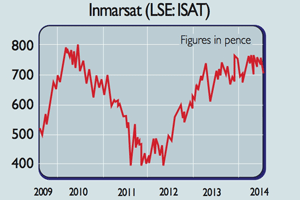Investing in space: How to buy into the final frontier
Pick the right firms and you could profit handsomely from a burgeoning market in commercial satellites and private space travel, says Matthew Partridge.


Pick the right firms and you could profit handsomely from a burgeoning market in commercial satellites and private space travel, says Matthew Partridge.
It might be hard to imagine now, but during the 1950s and 1960s,space travel actually got people excited.The rapid development of rocketry made the idea of visiting other worlds plausible.
The US and the Soviet Union poured resources into their space agencies as they competed to be the first to land on the moon. In 1968, Pan American World Airways (Pan Am) even began taking bookings for commercial space flights.
MoneyWeek
Subscribe to MoneyWeek today and get your first six magazine issues absolutely FREE

Sign up to Money Morning
Don't miss the latest investment and personal finances news, market analysis, plus money-saving tips with our free twice-daily newsletter
Don't miss the latest investment and personal finances news, market analysis, plus money-saving tips with our free twice-daily newsletter
However, by the time US astronaut Neil Armstrong finally made his "one small step for man, one giant leap for mankind", interest was starting to wane. It had become clear that space contained an awful lot of well, space and that our wilder dreams of space colonisation, or contact with other life forms, were not going to happen overnight. Public ennui helped to convince politicians that space travel was an unaffordable luxury.
US space agency Nasa's budget peaked (in inflation-adjusted dollars) in 1965. Today, it accounts for less than 0.5% of all US federal government spending, compared to 4.4% in its heyday a budget that goes alongside a far more pragmatic view of what we can hope to achieve in space.
This means an emphasis on unmanned flights and probes, and on finding bacteria and evidence of past life, rather than on colonising planets and encounters with little green men.
However, despite its lower profile and shrinking US government funding, the space industry itself has grown into a behemoth, worth more than $300bn. This is partly because more countries are developing their own space programmes, which are no longer seen as trophy projects available only to superpowers.
Meanwhile, private space travel is moving from fantasy to reality (at least for the super rich). And closer to Earth's orbit, the commercial satellite industry grows in leaps and bounds. In all, there's a vast and rapidly increasing market out there and one that investors can profit from if they find the right companies.
Space programmes go viral
Geopolitical experts largely agree that the world is becoming more multipolar "G-Zero" is the buzzword for a world with no superpower, not even America. This shift has been mirrored in the global space race, with growth in other nations more than compensating for any fall in US spending.
If you include joint ventures, as many as 70 countries have a space programme. Many of these are just agencies, with no serious spending power. However, a growing number are taking space travel very seriously indeed.
According to digital broadcasting and space and communication consultancy Euroconsult, nearly 30 nations spend more than $100m a year of public money on space programmes. And this is likely to be an underestimate, as much military-related spending is hidden.
The big spenders are those you'd expect, such as the UK and South Korea, but also include more surprising developing nations, such as Nigeria and Kazakhstan. Emerging economies are even among the eight nations spending more than $1bn a year Japan, China, France, Germany, Italy, India, Russia and America.
The Indian space programme has been especially controversial. Last November, India launched a rocket bound for Mars, which aims to look for signs of life by measuring the composition of Mars' atmosphere.
Critics have accused Delhi of wasting funds that could be better used for poverty alleviation or badly needed infrastructure. They also point out that since Britain gives a large amount of aid to India, British taxpayers are in effect subsidising India's space ambitions.
But whether or not it's a wise use of Indian or British resources, India's programme has already had some success.The most notable was the discovery of lunar water in 2009 by the ISRO Chandrayaan-1 Moon Impact Probe.
The findings, which challenged conventional scientific opinion, were later confirmed by detailed Nasa analysis. The probe also made a big contribution to the mapping of the moon, setting records for the number and quality of images transmitted. India now plans to send further probes to Venus andthe Sun.
Even the Russians are rejoining the space race. After the end of the Soviet Union, the Kremlin considered this low priority, focusing its resources on cooperative projects, such as the International Space Station. However, in the past year it has changed its mind, with plans to upgrade its space technology.
In May, Dmitry Rogozin (Russia's deputy prime minister) confirmed an extra $52bn in funding for space over the next six years, putting Russia back into second place in the world (behind America).
The dawn of commercial space travel
Meanwhile, in the private sector, there are signs that dreams of widespread commercial space travel may finally be near fruition. It has been possible to travel into space without becoming an official astronaut for quite some time.
The first space tourist' was Charles Walker, whose firm (McDonnell Douglas) paid Nasa $40,000 in 1984 to allow Walker to join the crew on a space shuttle mission. But efforts to havenon-specialists, such as journalists, regularly take part in US space flights were put on hold after the death of teacher Christa McAuliffe in the Challenger disaster in 1986.
Perhaps ironically, the biggest push for space tourism actually came from the other side of the Iron Curtain. With the economy imploding in the early 1990s, the Soviets let a Japanese journalist travel to the Mir Space Station (after undergoing training) in a deal worth millions of dollars.
Later, the Russians cut a deal with several British companies to allow one Briton, selected via a competition, to take part in another space trip. The deal collapsed, although in the end the Russian government decided the diplomatic benefits were compensation enough, and funded a scaled-down mission for Helen Sharman in 1991.
In 1999 Russia agreed a deal with commercial space company MirCorp to fund the Mir station's ongoing operation. As part of the agreement, American billionaire Dennis Tito was allowed to buy his way into a mission. The Mir station ended up being decommissioned before Tito's flight took place, and MirCorp eventually went bust due to financial mismanagement.
However, Tito eventually took part in a mission to the International Space Station in 2001. Tito's mission, and the ensuing publicity, encouraged six other multimillionaires to cut similar deals with the Russians Microsoft programmer Charles Simonyi paid $55m for two separate flights in 2007 and 2009.
But in the future, would-be astronauts may not need to rely on government space agencies. Two years ago SpaceX, run by technology tycoon Elon Musk, became the first private company successfully to carry out a mission to the International Space Station.
At the moment, its focus is on providing services to Nasa and commercial companies that may need to use the space station. But Musk's long-term plan is to set up a permanent human colony on Mars.
Musk has predicted that this could be achieved as early as 2026. While it may sound like something out of science fiction, given Musk's achievements in the field of electric cars, he can hardly be written off as a flake.
To cater to those looking for just a taste of space, several groups have turned their attention to sub-orbital flight. In 2004, Scaled Composites (now a subsidiary of Northrop Grumman) became the first private company to complete two flights that breached the Karman line, which marks the beginning of space.
Virgin Galactic plans to use a spaceship designed by Scaled Composites to offer regular flights across the line. While these flights will only last a few hours, rather than the days a full mission would need, the less stringent training requirements will push the cost down to $200,000, a fraction of the price of a trip to the International Space Station.
Over 530 people have reportedly paid deposits to reserve a flight, which, Richard Branson has promised, will begin later this year. That said, similar deadlines have been repeatedly missed over the last decade.
However, even if Branson fails again, it is almost certain that one of the other groups in the running will succeed.
The two leading competitors are XCOR Aerospace and EADS Astrium. XCOR plans to offer flights for only $95,000 half the price of Branson's venture.
It hopes to begin final testing next year, followed by a regular service from around 2018.The mining industry is also increasingly interested in the possibilities opening up in private space travel. With precious-metal extraction getting ever more expensive, it may become economical to get precious metals from other planets instead.
Two years ago a team of billionaires and academics set up Planetary Resources Inc. The initial idea is to build cheap, high-powered telescopes that can be launched into space to detect asteroids. The longer-term goal is to launch mining expeditions for rare and expensive minerals, such as platinum, palladium, osmium and iridium.
A satellite success story
For all the talk of other planets, the space industry has produced one unqualified success story that's very much about life on Earth the satellite business. According to US estimates, there are around 600 active satellites, providing everything from military surveillance to global communications.
The Satellite Industry Association (SIA) reckons the cost of servicing these satellites is around $120bn a year, while revenue generated by the sector comes in at around $195.2bn. Thanks to strong demand from firms and governments, the sector has seen double-digit sales growth for the last decade.
As well as making money for those firms maintaining and building them, satellites can have a dramatic economic impact at the country level, especially when they are used to avert disaster. In 1977, a cyclone in the Bay of Bengal killed at least 14,000 people. But when a similar cyclone struck the same area in 2013, there were only a handful of deaths.
What made the difference? A recently launched weather satellite enabled the authorities to track the cyclone's path and organise an evacuation of around 800,000 people.There are also hopes that better satellite surveillance could prevent wars.
Four years ago, Google announced an initiative that would allow aid agencies to monitor conflicts in otherwise inaccessible areas, such as Sudan. The hope is that they can deliver aid more accurately and learn of potential genocides quicker.
Satellite imagery is rapidly being adopted for other purposes too the US now allows private companies to sell satellite photos providing extremely high-resolution details that were once only available to the military and intelligence services.
Google has aggressively bought into this, signing a contract with satellite imaging specialist DigitalGlobe to provide images for services such as Google Earth. It is also developing its own capabilities it recently bought satellite specialist Skybox Imaging, with plans to launch up to 24 of its own satellites next year.
Google's long-term goal is to collect huge amounts of visual data, which can then be sold to firms that can use it to fine-tune their operations. There is already huge demand for such services in the investment community at least 25 hedge funds use satellite images of farmland and mines to get early warnings of potential problems that could affect earnings. We look at firms set to profit from this new space race' below.
The six stocks to buy now
Many of the biggest players in the space business are also heavily involved in aerospace and defence. Northrop Grumman (NYSE: NOC), for example, is a major contractor for both the US Army and Nasa. Recent space-related projects include key components for Nasa's solar probe mission and the James Webb Space Telescope, which will be 100 times more powerful than the Hubble Space Telescope.
It also owns Scaled Composites (mentioned above), which produces experimental aircraft. So far management has been able to maintain profit margins in the face of falling US military spending. It trades on 12.3 times 2015 earnings, with a solid dividend of 2%.
Lockheed Martin (NYSE: LMT) is another defence firm with a strong relationship with Nasa. Its major space project is the development of a new manned craft the Orion Multi-Purpose Crew Vehicle.
However, it is also attempting to strengthen its relationships with other countries it plans to open a space technology office in Oxford, hoping to benefit from the British government's commitment to develop the UK's space industry.
It has set itself a target of capturing 10% of the global space industry by 2030. Lockheed Martin has an attractive dividend (for a US stock) of 3.6% and trades on a forward price/earnings (p/e) ratio of 13.8.
Boeing (NYSE: BA) is best known for its aeroplane division.But it also has a track record of producing rockets and other space-related equipment, and a subsidiary that manages launches.
It is one of the final three firms in competition (along with SpaceX and Sierra Nevada Corporation) for the contract to build the next generation of Nasa shuttles, which have now been retired from service. If it gets the deal, it could mean revenues of $4bn. Boeing trades on 14.5 times 2015 earnings and yields 2%.

Satellite telecoms group Inmarsat (LSE: ISAT) specialises in satellite phones. These provide ready access to phone services and data where there is no mobile-telephone network or broadband coverage (or where those services are restricted by the government).
For now they are mainly used by businesses and aid agencies. In two years' time Inmarsat will launch a satellite that will significantly upgrade its capability in Europe, allowing it to deliver more data at a lower price.
The company currently trades on a pricey-looking 25 times 2015 earnings. However, this doesn't look unreasonable, given its rapid revenue growth, and the shares offer a solid dividend yield of 4%.
Orbital Sciences Corporation (NYSE: ORB) is a much purer play on the future of space. It's the top provider of the rockets used in satellites and smaller spacecraft, and also sells both missile delivery and missile defence systems.
Last year it made the first cargo delivery to the International Space Station as part of a $1.9bn contract. The share price has nearly doubled since we last tipped it almost two years ago (in issue 602). It is currently going through a merger with defence and aerospace group ATK, which is set to complete by the end of the year.
A less successful tip was satellite communications firm Avanti (LSE: AVN), whose share price has halved, due mainly to concerns over its financial position. However, broker Cantor Fitzgerald is optimistic it has a price target of 410p on the stock (from below 200p just now), partly due to Avanti managing to cut the costs of building and launching its next satellite,HYLAS 4, which will provide coverage in sub-Saharan Africa, by 15%-20%. Be warned it's a high-risk play, but it could pay off.
Get the latest financial news, insights and expert analysis from our award-winning MoneyWeek team, to help you understand what really matters when it comes to your finances.

-
 How much would it cost you to buy a house in Great Britain's happiest places?
How much would it cost you to buy a house in Great Britain's happiest places?Average asking prices for a property in the happiest place in Britain are below the national average
-
 How the Budget will hurt you: MoneyWeek Talks
How the Budget will hurt you: MoneyWeek TalksPodcast An Autumn budget podcast special episode, featuring MoneyWeek editors Kalpana Fitzpatrick, Andrew van Sickle and Cris Heaton.